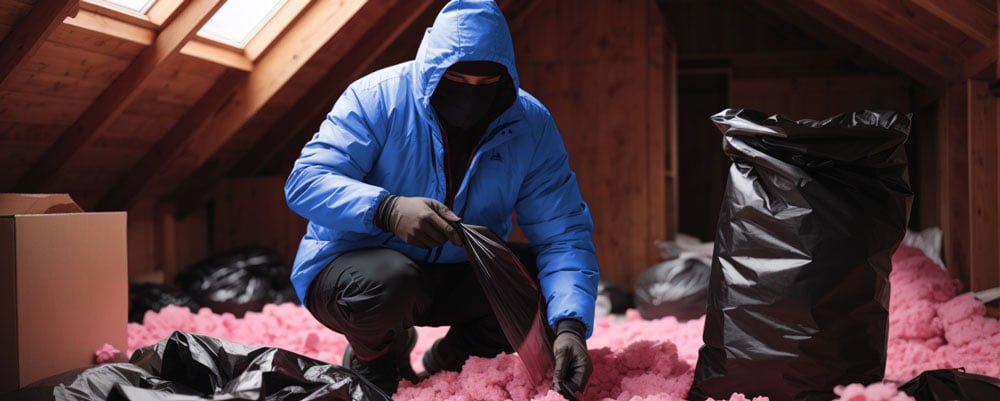Clearing the Air: Should You Remove Old Insulation Before Re-Insulating Your Home?
home insulation | existing wall insulation | foam university


"Out with the old, in with the new" is a mantra we often hear, and it couldn't be truer when it comes to reinsulating parts of your home.
But is it really necessary to remove that old, dusty insulation that's been part of your house's fabric for years?
Some might think a little extra padding could do no harm, maybe even add to the coziness. Yet, this isn't a fluffy pillow we're talking about—it's your home's insulation, and the answer to whether it should be ousted isn't merely drifting about in the breeze—it's a resounding yes, and here's the nitty-gritty on why.
The Lowdown on Crawl Space Insulation
Picture your crawl space as the forgotten junk drawer of your home.
It's out of sight, out of mind, and probably out of order.
When you're re-insulating, this hidden nook deserves a fresh start. The existing insulation? It's like an old filter that's seen better days—full of dust, allergens, and who-knows-what-else. It's not just about what you can see; it's about what you can't.
Dark or black markings on that pink or yellow fluff aren't a sign of character; they're a collection of tiny unwanted guests. And if you're sealing up your crawl space, you're also sealing in those unwanted particles right under your feet.
It's not just dirty; it's a health hazard. So, should old crawl space insulation be removed? Absolutely, unless you fancy your home's underbelly doubling as a dusty museum.
As a rule of thumb, if you are planning on adding spray foam insulation to the crawl space, then all of the old insulation needs to be removed so the foam has a clean surface to be sprayed onto.
Attic Insulation: A Double-Edged Sword
Now, let's ascend to the attic, a place where many homeowners wonder if they can double up on insulation for double the fun.
The truth? It's a double-edged sword.
If you're spraying new foam on the roof deck and leaving old insulation on the attic floor, you're not upping your home's cozy factor; you're creating a breeding ground for problems. That old insulation is like a sponge, and it's absorbed every attic adventure, from leaks to critter invasions.
Plus, when you insulate the roof deck, you're essentially bringing the attic inside your home's envelope. That means everything trapped in the old insulation is now a part of your indoor airspace. Odors, allergens, and the ghost of attics past—none of these make good housemates.
So, does attic insulation need to be removed? For the sake of your home's hygiene and harmony, yes.
A Question of Quality: Indoor Air and Odors
Indoor air quality is the invisible hero of a comfortable home.
But when old insulation overstays, it can release trapped odors and particulates into your living space.
The lesson here is simple: what's out of sight shouldn't be out of mind, especially when it comes to the air you breathe. The stuffiness, the sneezes, and the "what's-that-smell" comments can all be part of history if you clear out the old to make way for the new.
Installation Woes: Why Installers Aren't Fans of the Old Stuff
Think of your professional installers as artists.
They need a clean canvas to create their masterpiece, which is a well-insulated home.
Old insulation is like splatters of old paint on that canvas—it complicates things. If you have chosen spray foam insulation, those old layers can get in the way, reduce the effectiveness of the new insulation, and even get blown about, creating a mess and potentially compromising the new material.
The bottom line? Old insulation and new spray foam insulation don't mix well. It's like oil and water or cats and dogs.
The Case of Exterior Walls: Enclosed but Not Exempt
When it comes to exterior walls, you might think they're safe zones since everything is neatly enclosed.
But if you're peeling back the layers of your home and have the chance to remove old insulation, it's a golden opportunity. Out with the old, in with the efficiency. This makes spray foam a good fit.
However, if the walls are staying put and you're injecting new life into the walls, the existing insulation will be encapsulated—out of airflow and out of trouble. This is where RetroFoam injection foam comes into play.
RetroFoam is designed specifically to be injected into existing walls without the need to tear out the drywall, making it the best method for retrofitting wall insulation. So if you’re not planning a huge remodeling project in the future, you can still add new insulation to your walls without any hassle or cleanup.
Creating a Fresh Start in Your Home with New Insulation
Insulation is more than just material.
It's about creating a healthy, efficient, and comfortable living space. Removing old insulation might seem like an extra step, but it's a leap toward better air quality, increased efficiency, and peace of mind.
So, when you're looking to upgrade, don't just add—replace.
Ready to take the plunge into a cleaner, fresher home? Don't wait. Find a trusted RetroFoam dealer, and say hello to the future of home comfort.
It's time to remove the old and embrace the new because, in the world of insulation, clean starts lead to cozy finishes.
Related Articles
Can You Add RetroFoam to a Wall with Old Insulation?
What is Air Sealing Your Home with RetroFoam Insulation?
How to Insulate an Old House with RetroFoam without Damaging the Aesthetic
About Eric Garcia
Eric brings his knowledge and training in building science, training in spray and injection foams from the manufacturers, more than eight years installing foam insulation, as well as selling and managing in the foam insulation industry. He is also BPI and Dale Carnegie certified and has taken several building science courses, including air sealing and building envelope. Eric is the Professor of Foam on our educational YouTube series Foam University. Even when Eric is off he is usually still “working” or thinking about work, but when he can get away he enjoys camping, hiking, hunting, and woodworking.



